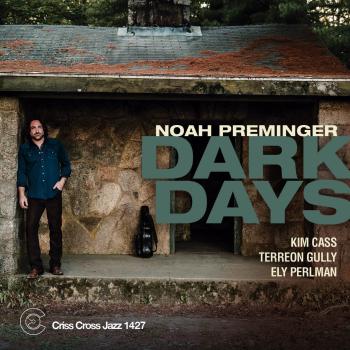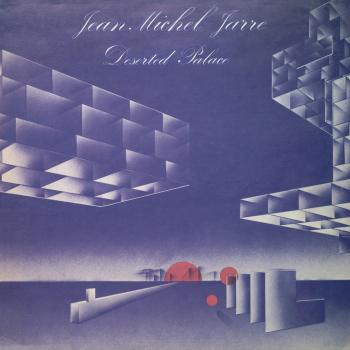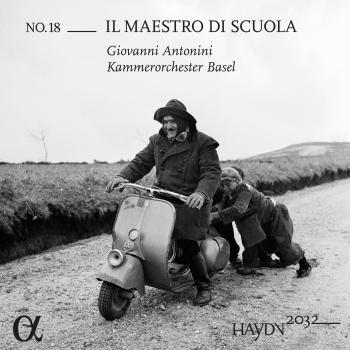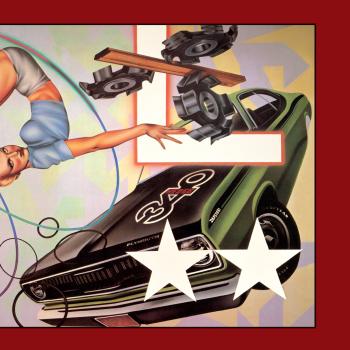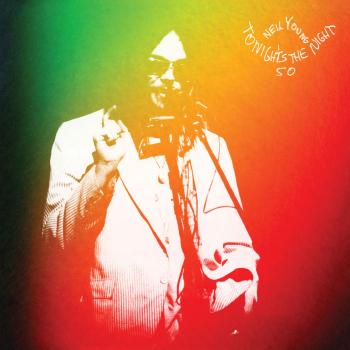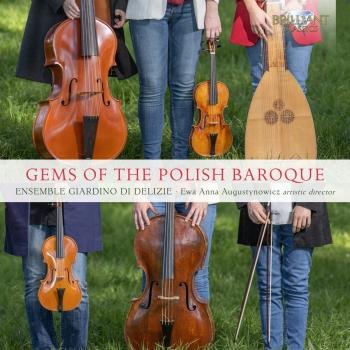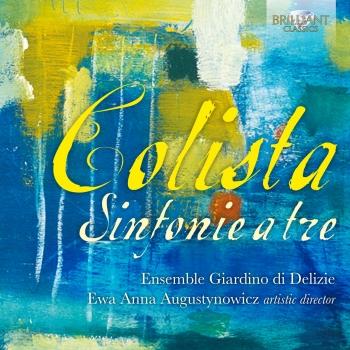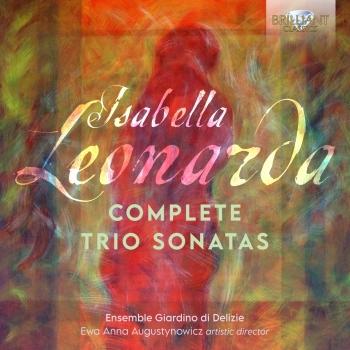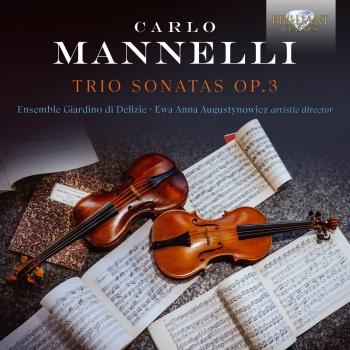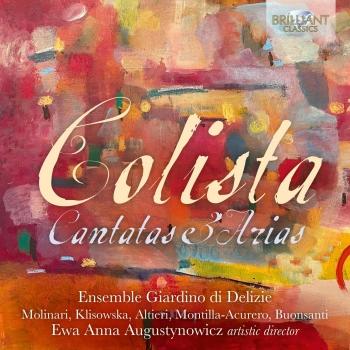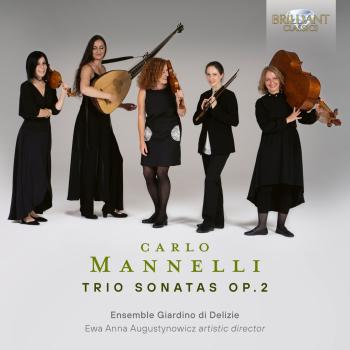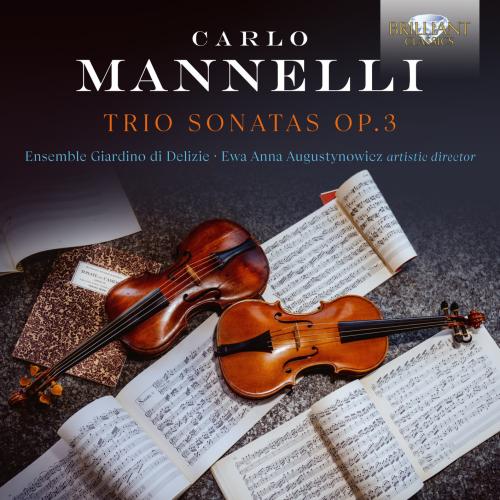
Mannelli: Trio Sonatas, Op. 3 Ensemble Giardino di Delizie & Ewa Anna Augustynowicz
Album Info
Album Veröffentlichung:
2023
HRA-Veröffentlichung:
24.02.2023
Label: Brilliant Classics
Genre: Classical
Subgenre: Chamber Music
Interpret: Ensemble Giardino di Delizie & Ewa Anna Augustynowicz
Komponist: Carlo Mannelli (1640-1697)
Das Album enthält Albumcover Booklet (PDF)
- Carlo Mannelli (1640 - 1697): Sonata No. 4 in A Major, Op. 3, vivace, canzone, adagio, capriccio:
- 1 Mannelli: Sonata No. 4 in A Major, Op. 3, vivace, canzone, adagio, capriccio 05:50
- Sonata No. 5 in B Minor, Op. 3, adagio, non presto, fuga, adagio cantabile, aria allegro, capriccio:
- 2 Mannelli: Sonata No. 5 in B Minor, Op. 3, adagio, non presto, fuga, adagio cantabile, aria allegro, capriccio 09:01
- Sonata No. 7 in D Major, Op. 3, vivace, canzone, adagio, capriccio:
- 3 Mannelli: Sonata No. 7 in D Major, Op. 3, vivace, canzone, adagio, capriccio 06:45
- Sonata No. 9 in E Minor, Op. 3, non presto, lento, adagio, fuga, adagio, aria. largo solo:
- 4 Mannelli: Sonata No. 9 in E Minor, Op. 3, non presto, lento, adagio, fuga, adagio, aria. largo solo 09:47
- Sonata No. 3 in A Minor, Op. 3, vivace, fuga, adagio, capriccio:
- 5 Mannelli: Sonata No. 3 in A Minor, Op. 3, vivace, fuga, adagio, capriccio 04:48
- Sonata No. 8 in E Minor, Op. 3, allegro, vivace, capriccio, adagio assai, canzone allegra, adagio, aria:
- 6 Mannelli: Sonata No. 8 in E Minor, Op. 3, allegro, vivace, capriccio, adagio assai, canzone allegra, adagio, aria 07:33
- Sonata No. 12 in A Minor, Op. 3, allegro, allegro, lento. Smorzi spesso & ondegiato:
- 7 Mannelli: Sonata No. 12 in A Minor, Op. 3, allegro, allegro, lento. Smorzi spesso & ondegiato 07:04
- Sonata No. 11 in F Major, Op. 3, adagio-vivace, canzone, adagio, capriccio:
- 8 Mannelli: Sonata No. 11 in F Major, Op. 3, adagio-vivace, canzone, adagio, capriccio 05:09
- Sonata No. 1 in G Minor, Op. 3, allegro, allegro, canzona. vivace, adagio, capriccio:
- 9 Mannelli: Sonata No. 1 in G Minor, Op. 3, allegro, allegro, canzona. vivace, adagio, capriccio 05:56
- Sonata No. 10 in F Major, Op. 3, adagio, adagio cantabile, adagio ondegiato forte e piano, allegro:
- 10 Mannelli: Sonata No. 10 in F Major, Op. 3, adagio, adagio cantabile, adagio ondegiato forte e piano, allegro 05:52
- Sonata No. 6 in C Minor, Op. 3, cantabile-adagio, aria, adagio, canzone larga, allegro:
- 11 Mannelli: Sonata No. 6 in C Minor, Op. 3, cantabile-adagio, aria, adagio, canzone larga, allegro 10:35
- Sonata No. 2 in G Major, Op. 3, allegro, fuga, adagio, capriccio. Non presto:
- 12 Mannelli: Sonata No. 2 in G Major, Op. 3, allegro, fuga, adagio, capriccio. Non presto 07:01
Info zu Mannelli: Trio Sonatas, Op. 3
The forgotten art of a 17th-century Roman master, in the hands of a dynamic period ensemble with a string of acclaimed rarity albums to their credit.
The Baroque trio-sonata repertoire still yields up plenty of undiscovered treasure lying in libraries across Italy. The Ensemble Giardino di Delizie has been diving into it and coming up with polished gems on Brilliant Classics by Stradella (96079), Colista (96033) and Lonati (95590). Like Colista, Carlo Mannelli (1640-1697) was Roman by birth and training. He sang and played the violin for ensembles at both church and court, and was permitted to dedicate his Op.2 collection to Cardinal Benedetto Pamphilj.
Perhaps it was the patronage of this influential family that opened doors to his training with Michelangelo Rossi, and to distinguished musical societies in Rome. Another noble Roman family was the recipient of Mannelli’s Op.3 collection of trio sonatas, with its dedication to Prince Domenico Rospigliosi. Much of the composer’s output is now lost, and we can only surmise at the riches deprived to us by time, given the fresh melodic invention of what survives here.
Compared to Stradella and co, Mannelli cuts an eccentric, highly individual figure, musically speaking, and he has no interest in the orderliness of Corelli. The arrangement of slow and fast movements is unpredictable: the four-movement No. 10 begins with three separate Adagios! The six-movement No.9 cuts a sequence of four slow movements in half with a fugue, and so on. Three of the twelve sonatas feature a ravishing aria for the violin, who takes on a soloist’s role.
When Mannelli writes quick music, he pushes his musicians to the limits, as in the finale of the First Sonata. Counterpoint is subordinate to the kind of highly elaborate violin writing at which Ewa Anna Augustynowicz has already shown herself to excel in previous albums, making this new recording an essential acquisition for Baroque-music aficionados.
Carlo Mannelli (Rome, 1640-1697) spent the major part of his life in Rome where he also worked during the opera performances and religious events. As a violinist nicknamed Carlo del Violino and Carluccio di Pamfili, he played the first violin in the most famous Roman musical ensembles of the period. Arcangelo Corelli, who often played under Mannelli, described him as one of his most influential teachers. For several years, Mannelli was leader of the famous Congregetione di S. Cecilia.
The Trio Sonatas Op.3 consists of twelve Sonatas. Seven of them are in four movements, two are in six movements and only one (the last) is in three movements. They display a freshness of melodic invention and sometimes daring harmonic surprises, a great tonal richness and unexpected, highly expressive chromatic phrases.
The ensemble Giardino di Delizie is a Roman female Baroque group, founded in 2014 by the violinist Ewa Anna Augustynowicz, researching and performing forgotten treasures from the Italian and Polish Baroque. They played in such ensembles as Europa Galante, Les Eléments, Quatuor Mosaïques and others. Their previous recordings of instrumental works by Lonati, Stradella, Colista and Leonarda met with enthusiast critical acclaim in the international press: ‘The performance sounds completely natural, full of spontaneity and bursting energy. It’s clear the group really likes this music and does not merely try and lecture it.’ (Lonati, 95590 theclassicreview.com). ‘Giardino di Delizie… take an energetic and imaginative approach to this fine music… playing with sensitivity and considerable musicality.’ (Colista, 96033, earlymusicreview.com). ‘A garden of delights, sensitively and beautifully performed, perfect for any lover of the Baroque.’ (Gems of the Polish Baroque, 95955, MusicWeb International).
Ensemble Giardino di Delizie
Ewa Anna Augustynowicz, artistic director
The Ensemble Giardino di Delizie
is a Roman Baroque Ensemble and was founded in 2014 by its artistic director Ewa Anna Augustynowicz, PhD. The ensemble is a collective of Polish, Italian and Eastern European musicians and has a varying structure from string duets to small chamber orchestra and its musicians specialized with internationally renowned masters, such as Enrico Onofri, Marco Ceccato, Enrico Gatti, Andrea Coen, Giovanni Togni, Dmitry Sinkowsky, Amandine Beyer, Marco Testori. Franco Pavan etc. In addition to the high level of training and specialization, the members of the group work regularly with different ensembles including Les Eléments, Divino Sospiro, Capella Cracoviensis, Accademia Montis Regalis, Europa Galante, Arianna Art Ensemble, Collegium Pro Musica, Quatuor Mosaiques, Concerto Romano, Accordone and Pomo d'Oro.
Alongside the musical activity, the ensemble also conducts research in the field of musicology with particular regard to the Roman and Polish Baroque repertoire, rediscovering forgotten authors and trying to draw bridge between these two countries. Due to its unique binational character, the ensemble is particularly interested in the peculiarities of their own musical languages. The musicians are strongly convinced of the need of “saper ben parlare per ben suonare”, thus their research starts with a proper phonetic analysis of each langugaes to make them present in the execution and interpretation of the musical pieces. Hence, their performances are rich in sweet tones of Italian Corellian passages on the one side and and vigorous and lively sounds of the Polish dances on the other side. The ensemble’s performances, particularly intense and exciting, are in fact the result of extensive historical surveys to rediscover masterpieces of Italian composers who have had the center of its activities in the Rome of Alessandro Stradella, Arcangelo Corelli and Alessandro Scarlatti during the long poignant and bright sunset of the Roman polyphonic style and those of Polish and Italian composers such as Marcin Mielczewski, Adam Jarzebski, Tarquinio Merula who had their centre of activity at the court of the Polish kings.
The ensemble is based in Rome and since its foundation pursued its activity in important institutions such as the Circle of the Armed Forces at the Ministry of Defence in Rome, Umberto Theatre, the Polish Church of St. Stanislaus in Rome, different cultural associations and others. The group participated in festivals such as the Festival of Music Rome; Almisonis Melos Chivasso, Turin; Musica Antica a San Rufo, Rieti; Sulle Ombre del Cusanino Filottrano, Marche; Santa Rita Basilica of Cascia and Concerti di Campagna, Monte Compatri. In August 2016 the ensemble performed with a great success at two important European festivals: the BRQ Vantaa Music Festival (Helsinki) and the Oude Musik Festival (Utrecht). In February 2017 the ensemble went on tournee in Poland giving concerts as a special guest at the Schola Cantorum Early Music Festival in Kalisz, at the Wilanow Palace in Warsaw and for the Societa Dante Alighieri in Katowice. In August 2017 the ensemble played with a great succes at the festival Barok na Spiszu in Poland. In 2018 Giardino di Delizie performed Polish Baroque music in various occasions celebrating 100 anniversary of the Polish independence (Turin University, Societa’ del Giardino in Milan, Museum of Instruments in Rome). In December 2018 the ensemble played in Naples for the concert series organized by Centro della Pietà de’ Turchini. The ensemble has been invited to perform during the Festival de Música Antiga dels Pirineus in Spain in 2019.
Recently, as a result of intense musicological research, the ensemble recorded its first CD for Brilliant Classics with 10 Triosonatas by Carlo Ambrogio Lonati, a still quite unknown Roman Baroque composer. It is the first modern recording of all these sonatas and Carlo Ambrogio Lonati and Roman composers are in focus of ensemble's musicological survey. In April 2019 the group has recorded its second CD, this time of the 17th century Polish Baroque Composers. This CD should be published by Brilliant Classics at the beginning of 2020. The group is already working its 3d CD with never recorded music to be recorded in the Autumn 2019. The musicians of the Giardino di Delizie perform their repertoire on historical instruments, copies of important Italian manufacturers.
Booklet für Mannelli: Trio Sonatas, Op. 3



